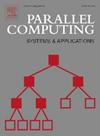基于GPU的多用户MIMO上行检测软件加速
IF 2.1
4区 计算机科学
Q2 COMPUTER SCIENCE, THEORY & METHODS
引用次数: 0
摘要
本文介绍了基于gpu加速的分块分解的零强迫(ZF) QR和Cholesky方法应用于大规模多输入多输出(MIMO)上行检测算法的探索。评估了三种算法:块Cholesky分解ZF、块QR分解(QRD) ZF和块Cholesky分解最小均方误差(MMSE)。后者是之前唯一被探索过的,但它使用了标准的乔列斯基分解。我们的方法比以前的gpu加速MMSE研究提高了11%。通过性能分析,我们观察到精度和执行时间之间的权衡。在128 × 8 MIMO尺寸下,基于zf的QRD将执行时间从2.04μs降低到1.24μs,从而提高了误码率(BER),但精度从FP64降低到了FP32,提高了执行时间。该研究还强调,更大的MIMO尺寸,特别是2048 × 32,需要gpu充分利用其计算和存储能力,特别是在FP64精度下。相反,较小的矩阵是计算受限的。我们的研究结果推荐gpu用于更大的MIMO规模,因为它们提供了有效处理下一代网络计算需求所需的并行性和内存资源。这项工作为可扩展的、基于gpu的大规模MIMO上行检测系统铺平了道路。本文章由计算机程序翻译,如有差异,请以英文原文为准。
Software acceleration of multi-user MIMO uplink detection on GPU
This paper presents the exploration of GPU-accelerated block-wise decompositions for zero-forcing (ZF) based QR and Cholesky methods applied to massive multiple-input multiple-output (MIMO) uplink detection algorithms. Three algorithms are evaluated: ZF with block Cholesky decomposition, ZF with block QR decomposition (QRD), and minimum mean square error (MMSE) with block Cholesky decomposition. The latter was the only one previously explored, but it used standard Cholesky decomposition. Our approach achieves an 11% improvement over the previous GPU-accelerated MMSE study.
Through performance analysis, we observe a trade-off between precision and execution time. Reducing precision from FP64 to FP32 improves execution time but increases bit error rate (BER), with ZF-based QRD reducing execution time from to for a 128 × 8 MIMO size. The study also highlights that larger MIMO sizes, particularly 2048 × 32, require GPUs to fully utilize their computational and memory capabilities, especially under FP64 precision. In contrast, smaller matrices are compute-bound.
Our results recommend GPUs for larger MIMO sizes, as they offer the parallelism and memory resources necessary to efficiently handle the computational demands of next-generation networks. This work paves the way for scalable, GPU-based massive MIMO uplink detection systems.
求助全文
通过发布文献求助,成功后即可免费获取论文全文。
去求助
来源期刊

Parallel Computing
工程技术-计算机:理论方法
CiteScore
3.50
自引率
7.10%
发文量
49
审稿时长
4.5 months
期刊介绍:
Parallel Computing is an international journal presenting the practical use of parallel computer systems, including high performance architecture, system software, programming systems and tools, and applications. Within this context the journal covers all aspects of high-end parallel computing from single homogeneous or heterogenous computing nodes to large-scale multi-node systems.
Parallel Computing features original research work and review articles as well as novel or illustrative accounts of application experience with (and techniques for) the use of parallel computers. We also welcome studies reproducing prior publications that either confirm or disprove prior published results.
Particular technical areas of interest include, but are not limited to:
-System software for parallel computer systems including programming languages (new languages as well as compilation techniques), operating systems (including middleware), and resource management (scheduling and load-balancing).
-Enabling software including debuggers, performance tools, and system and numeric libraries.
-General hardware (architecture) concepts, new technologies enabling the realization of such new concepts, and details of commercially available systems
-Software engineering and productivity as it relates to parallel computing
-Applications (including scientific computing, deep learning, machine learning) or tool case studies demonstrating novel ways to achieve parallelism
-Performance measurement results on state-of-the-art systems
-Approaches to effectively utilize large-scale parallel computing including new algorithms or algorithm analysis with demonstrated relevance to real applications using existing or next generation parallel computer architectures.
-Parallel I/O systems both hardware and software
-Networking technology for support of high-speed computing demonstrating the impact of high-speed computation on parallel applications
 求助内容:
求助内容: 应助结果提醒方式:
应助结果提醒方式:


